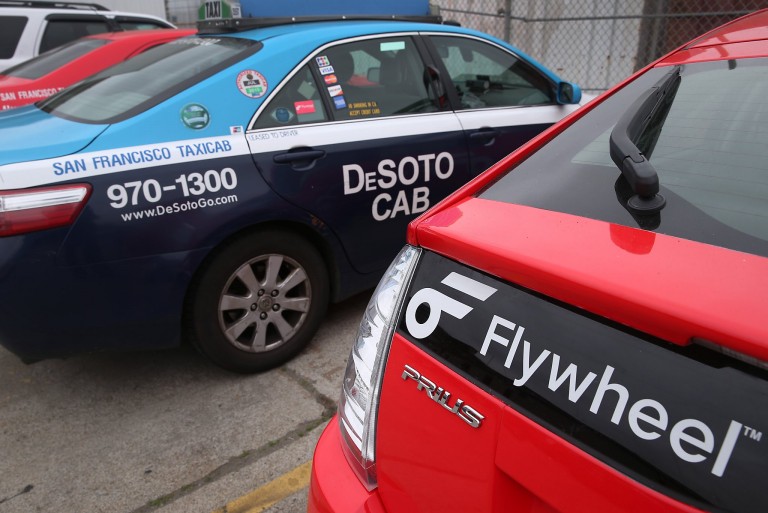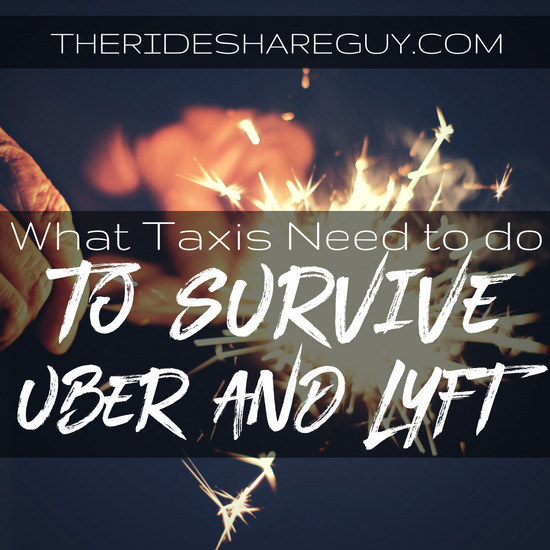Harry here. We get asked about the future of the taxi industry a lot and while their market share is declining, it seems like there are still lots of taxis on the streets. Today, senior RSG contributor Christian Perea takes a look at what the taxi industry needs to do to not only survive, but thrive against rideshare giants like Uber and Lyft.
I’m sure I don’t need to tell anybody that the taxi industry isn’t doing so well these days. In fact, over the past 5 years the entire industry has been crushed and overrun by transportation network companies (TNCs) like Uber and Lyft. And it seems like every person with a car and a smartphone is scouring through the streets and stealing their rides. Uber and Lyft have also managed to get laws and regulations passed in a majority of states that essentially legalize rideshare and establish separate regulations for them.
Cabs claim these separate rules create an un-level playing field by allowing TNCs to flood the streets with cars and charge (much) lower prices than cabs can charge. A lawsuit against this anticompetitive nature was recently shot down, allowing for separate regulations for TNCs to continue.
To make matters worse, after years of “My credit card machine doesn’t work! Let me drive you to the nearest farthest ATM!” the public doesn’t have much sympathy for the cab industry, which they have demonstrated through their wide adoption of Uber.
So what can Big Taxi do to survive in the 21st Century? What is going to happen when their clientele dies off? Well it doesn’t seem like Uber is going away anytime soon so maybe traditional cab companies should become TNCs themselves and fight fire with fire.
The lines are already blurred. TNCs are becoming more like traditional cab companies in many ways, with vehicle rentals, leases, disgruntled drivers, and a separate regulation model. Some taxi companies have built their own apps and started to recruit disgruntled TNC drivers. So here’s what taxis need to do to survive Uber and Lyft.
1. Immediately Spin-off Their Companies Into TNCs
Fight fire with fire.
The message regulators have been sending is that they will not do anything to stop Uber or Lyft from existing. The apps have too much support from the public and it’s not in their political interest to support a few thousand cab drivers. That is why there is a separate set of rules and regulations for companies like Uber. One judge even went as far as saying they are as different as cats and dogs while ruling on a lawsuit around the anticompetitive nature of Chicago regulations.
So why not instead choose to compete on the same level?
- It is clear that this “other” model of vehicle-for-hire regulation is taking over; and that regulators will let the Big Taxi model wither on the vine.
- What is to stop other companies from competing on the same TNC model? Or even lobbying for a hybrid model?
- Joining this model would position Big Taxi to compete on a level playing field while also leveraging their existing strengths.
- Better align themselves with customers demand, convenient, trackable, cheaper transportation.
It’s already (sorta) happening: Apps like Flywheel and Curb allow passengers to get a lot of the things they prefer from the Uber and Lyft apps. They can hail a cab through their smartphone and pay through a credit card that is already on file. The big difference here is that these are still cab companies, with higher cab rates.
2. Stop Making TNC Drivers and Passengers Villains
Websites like “Who’s Driving You?” spend a lot of energy pointing out every single Uber or Lyft incident. The problem with this strategy is that everything they post is also applicable to cab drivers. Every time they post a story about Uber/Lyft drivers to social media, most people just say to themselves “oh there goes those desperate and angry cab drivers again… being all angry… glad Uber is here. At least it’s tracked on the phone…”
One of the first posts I saw on the “Who’s Driving You?” Facebook page was a story about how an Uber driver had kicked out a transgender woman. Now obviously that’s not right, but you can’t pretend to tell me with a straight face that cab drivers don’t do this all the time (in fact, this was the reason why the idea for Sidecar was invented). That’s the problem. The entire campaign against Uber drivers actually highlights and reminds the public about everything they hated about using a taxi. And it also alienates Uber drivers from siding with cab companies.
Cab drivers actually used to take photos of rideshare drivers license plates and mail them to insurance companies in hope of getting that driver dropped from their insurance policy. I once had a Luxor cab back into my car once and speed off. He straight up rammed me!

We are More Alike Than Different You Know…
- We stand in the same parking lots. Complain about the same shady and seedy customers, and are both fighting against large corporations with special ties to regulators.
- We all get the same lower back pain and know the best places to pee at 2 AM.
- Just trying to earn an extra dime in an increasingly confusing world where it is harder to get by.
- Our cars may be different colors on the outside, but they are the same Prius on the inside.
Instead, the taxi industry should focus on uniting rideshare drivers and organizing them to support their agenda. Every rideshare driver and customer is a potential taxi customer. What’s sad is that Who’s Driving You actually has some accurate criticisms on their page, but it just comes across as way too biased.
3. Re-brand Public Image For the 21st Century

Taxis have a public image problem in the US, especially with millennials and younger customers. Uber actually now has some of the same problems that cabs traditionally have had: inexperienced drivers, old cars, and ride discrimination to name a few. But I think cab drivers are better than Uber drivers regarding actual driving, safety and navigation. A new public image should reflect this strength and starting a new rideshare company would provide the opportunity to do so.
Say what you will about the habits of millennials and Uber users, but they are a huge potential customer base that is only going to get bigger. The taxi industry needs to figure out how to get these people to switch over. So what should cab companies do to address this market?
- Compete on reliability, price, and convenience. Make requesting a ride as seamless as requesting an Uber.
- Re-position their brand as the BEST system for quality, price, and social responsibility. Advertise driver treatment as more equitable and recruit rideshare drivers to directly combat Uber and Lyft while interfering with their supply.
- Continue to operate wheelchair accessible vehicles.
- Talk about how you have worked with transit agencies and community organizations for last 120 years.
Good Example: Flywheel was formerly DeSoto cab and relaunched with new branding after building out their own app to summon a taxi. Harry actually interviewed their found on the podcast in episode 33.
I think Flywheel is a good example of how the taxi industry can re-brand for millennials and shed inaccurate stereotypes about cabs in general. They are still a taxi company, but simply re-branding themselves opened them up to a whole new base of customers. Anecdotally, some of the less price sensitive rideshare customers in San Francisco prefer the Flywheel experience because their drivers have years of experience, know where they’re going and aren’t just a guy with a car.
4. Stop Being Reactive
People have been sitting around waiting for a meaningful cab industry reaction for a long time. Many thought cabs would crush Uber in court or through street enforcement, or by taking pictures of rideshare drivers license plates and mailing them to insurance companies. Yet everything done has been negative, reactive, or even sometimes violent in nature (France).
Yet none of that is getting them any public sympathy since most of these tools have been reactive. They reflect the old ways of protecting an insulated industry, but that industry is no longer insulated and these tools will not work.
Uber and Lyft are a different animal. The cab industry is trying to fight a symmetrical war against an asymmetrical opponent that is running rings around them.
A Bitter Pill
Nobody in Big Taxi wants to make this change. From a driver perspective, I surely wouldn’t want to go from driving under taxi rates (~$2.25/mile) to driving under UberX rates (~$1.00/mile). However, keeping those pay rates right now requires sticking to a model regulators are letting die. Nobody says that rates have to be $1.00/mile. Or that cab companies should clone themselves as Uber or Lyft.
Both major TNCs have problems that are ripe for being taken advantage of. They can’t seem to retain drivers for more than a few months. Neither company does much to provide Wheelchair Accessible Vehicles for the public (especially Lyft). They refuse to drug-test or fingerprint their drivers, and provide very little training.
Cab companies should find a way to get on this looser “track” of regulations so they can have more flexibility in competing and even growing. Uber has already spent a few billion dollars building out the passenger base, lobbying regulators, building driver supply, and driving app adoption as the first entrant. Go take it.
Readers, what do you think about the plight of taxi cab drivers? If you drive or drove for a taxi, what do you think about our suggestions for taking back rideshare driving?
-Christian @ RSG
Save
Save






